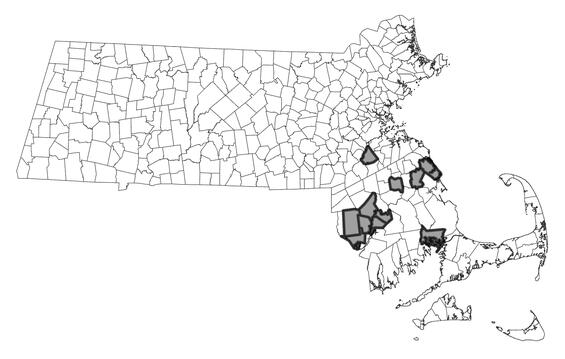- Scientific name: Cardamine longii
- Species of Greatest Conservation Need (MA State Wildlife Action Plan)
- Endangered (MA Endangered Species Act)
Description
Long’s bittercress (Cardamine longii) is a small (15-58 cm; 6−24 in), globally rare perennial wetland herb of muddy, typically tidal, river and creeks shores. This species is a member of the mustard family (Brassicaceae); unlike many other species of this family, Long’s bittercress lacks a rosette of leaves at the base of the plant. Its leaves, which are borne on petioles, are primarily simple, with small (0.5−2 cm; <1 in.) kidney-shaped to rounded blades, and smooth to wavy margins. Some leaves may be pinnate, having up to one pair of lateral leaflets, but these are much smaller than the terminal leaflet. Long’s bittercress has very small (<6 mm; 0.2 in), inconspicuous flowers arranged in racemes borne from the side of branches. It produces dehiscent, many-seeded fruits, or siliques, that are linear, narrow, and short (5-10 mm × 1.5 mm; 0.2-0.4 × 0 .06 in). The fruits are spreading to ascending on short and stout pedicels. Long’s bittercress has a number of key characteristics that differentiate it from other bittercress species. Particularly diagnostic are the chiefly simple leaves, petal-less flowers, and relatively short fruits (≤10 mm; 0.4 in) on short (≤2 mm; 0.79 in) widely spreading stalks.
Bittercresses and toothworts (i.e., Cardamine spp.) are a ubiquitous group of plants typically thriving in moist or wet habitats with eight species (six native) known to occur in Massachusetts. Species are generally small, annual or perennial, herbs with mostly pinnately-lobed leaves, small whitish flowers, and relatively long and slender fruits.
There are a few similar mustard species that could be found in Long’s bittercress habitat and that could cause confusion. The young, sterile rosettes of water-cresses (Nasturtium spp.) can be very similar to those of Long’s bittercress; however, these species root at the stem nodes whereas Long’s bittercress does not.
In reproductive condition, the yellow flower color and fruit shape (round in cross-section) of water-cresses allow for easier differentiation. Common bittercress (Cardamine pensylvanica) is distinguished from Long’s bittercress by its larger (4−10 cm; ~1.6−4 in), shallowly toothed or toothless pinnate leaves with 5 to 11 broadly elliptical leaflets, white flowers, longer fruiting pedicels (5-10 mm; 0.2-0.4 in), and longer (2−3 cm; 0.8-1.2 in) slender fruits. Like Long’s bittercress, spring-cress (Cardamine bulbosa) also has simple leaves, but differs from Long’s bittercress with its large white flowers (petals >7 mm; 0.28 in), longer fruits (>2 cm; 0.8 in), and bulbiferous rhizomes. Lastly, yellow water-cress (Rorippa palustris) is easily distinguished from Long’s bittercress by its bright yellow flowers, greater height (plants 3-10 dm; 1 -~3 ft), often hairy stems and leaves, and longer (6-20 cm; 2.3-8 in) irregularly serrate pinnate leaves.

Population status
Long’s bittercress is listed under the Massachusetts Endangered Species Act as Endangered. All listed species are protected from killing, collecting, possessing, or sale and from activities that would destroy habitat and thus directly or indirectly cause mortality or disrupt critical behaviors. The MassWildlife’s Natural Heritage & Endangered Species Program database has 13 records from 6 counties: Bristol, Hampshire, Middlesex, Norfolk, Plymouth, and Worcester. Ten of these records have been observed within the last 25 years.
Distribution and abundance
Long’s bittercress has a narrow coastal distribution, with a range extending from southern Maine south through the Atlantic Seaboard states to North Carolina.

Distribution in Massachusetts
1999-2024
Based on records in the Natural Heritage Database
Habitat
Long’s bittercress is known primarily from sandy shores or mudflats of freshwater tidal rivers and marshes in coastal areas, though two records are known from non-tidal streams. In tidal rivers and creeks, plants often occur along portions of higher stream banks, shaded under overhanging vegetation, where individuals may be submerged under high tide conditions and exposed during low tides. Plants found in association with Long’s bittercress in Massachusetts include wild rice (Zizania aquatica), pickerelweed (Pontederia cordata), narrow-leaved cat-tail (Typha angustifolia), rigid bulrush (Schoenoplectus acutus), and the two rare species Parker’s pipewort (Eriocaulon parkeri; Endangered) and estuary beggar-ticks (Bidens hyperborea; Endangered).
Healthy habitats are vital for supporting native wildlife and plants. Explore habitats and learn about conservation and restoration in Massachusetts.
Threats
Because this plant occurs in freshwater tidal marshes and stream banks, presumably any alteration in the hydrologic regime or increased sedimentation due to changes in adjacent land use could impact the species.
Conservation
As for many rare species, exact needs for management of Long’s bittercress are not known. However, competition from invasive wetland species could reduce the available habitat of Long’s bittercress. All active management of state-listed plant populations (including invasive species removal) is subject to review under the Massachusetts Endangered Species Act and should be planned in close consultation with the MassWildlife’s Natural Heritage & Endangered Species Program.
References
Padgett, D.J., L. Cook, L. Horky, J. Noris and K. Vale. 2004. Seed production and germination in Long’s bittercress (Cardamine longii) of Massachusetts. Northeastern Naturalist 11:49-56.
Contact
| Date published: | April 8, 2025 |
|---|